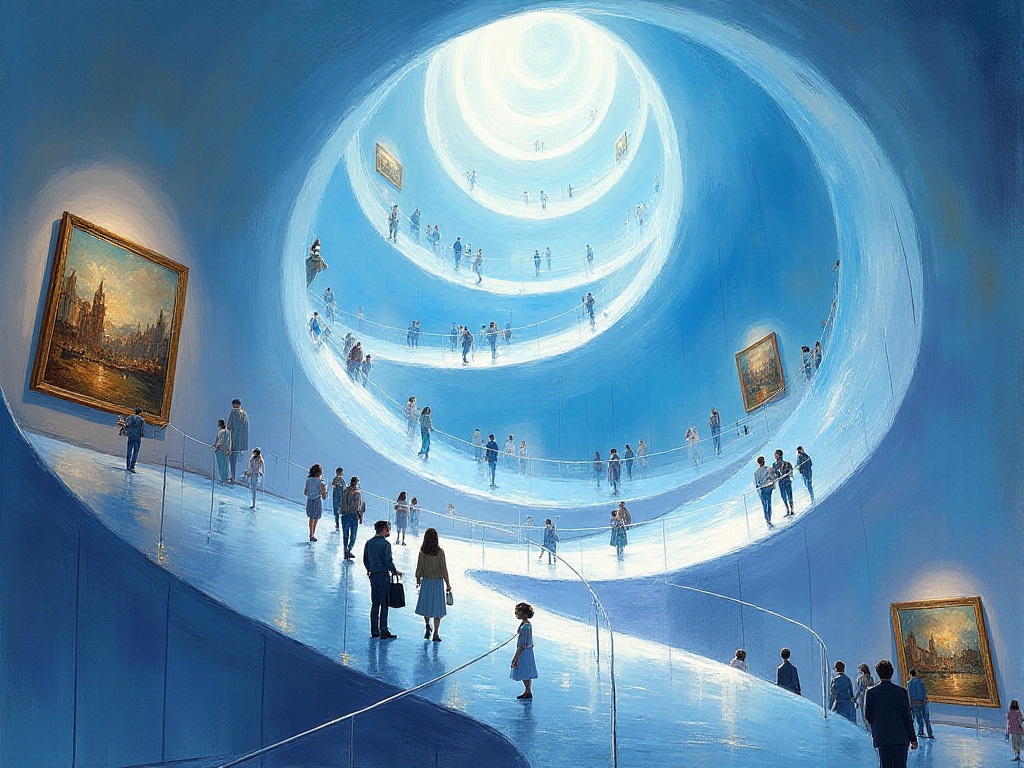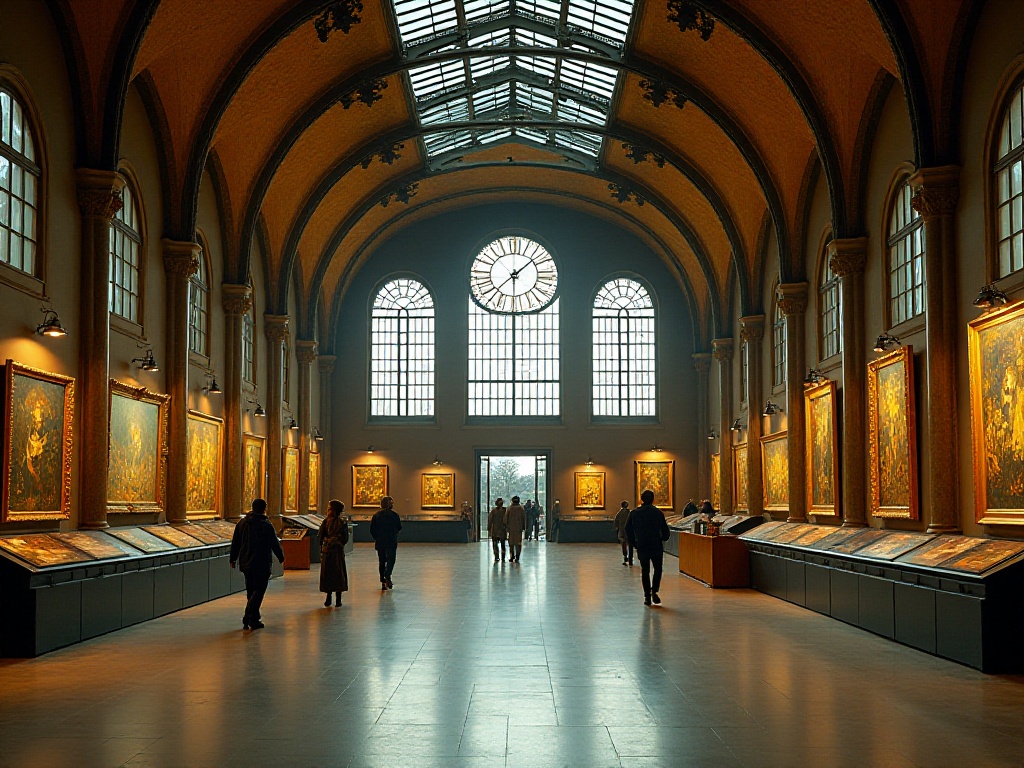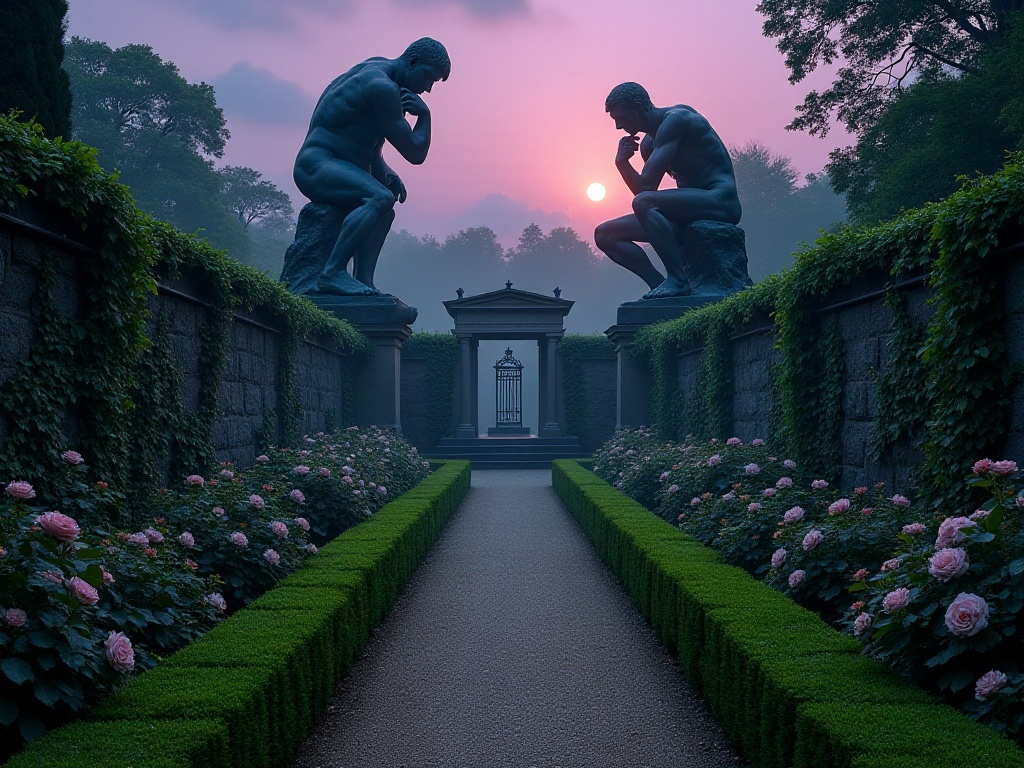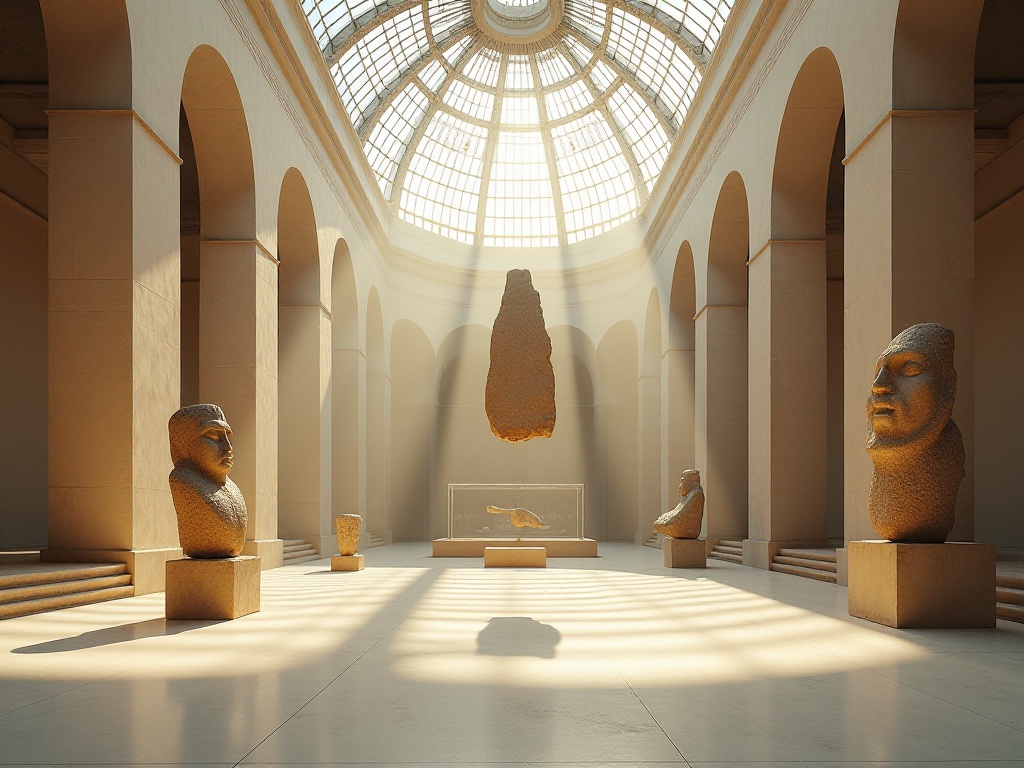First Encounter with Musée d'Orsay
Standing in front of the Musée d'Orsay, I was deeply drawn to this building's character. Under Paris's distinctive grayish-white sky, the ancient bronze station clock still ticks accurately, witnessing this building's transformation from the late 19th century to the present. This once bustling train station has now elegantly transformed into an art sanctuary.
From my first step into the museum, I was struck by its unique atmosphere. The entrance is paved with dark marble floors reflecting the light from crystal chandeliers above. A huge old photograph on the wall shows the busy scene when this was a train station: steam trains billowing white smoke, travelers in late 19th-century attire hurrying back and forth, platforms piled with various suitcases.
As an art enthusiast, I had long heard of the Musée d'Orsay's reputation. It's one of the world's most important collections of Impressionist art, housing over 4,000 Impressionist and Post-Impressionist art treasures. These pieces are all priceless, each telling a unique story in art history.
The building's past and present are also fascinating. In 1900, this train station was designed by Victor Laloux for the Paris World's Fair. At the time, the Orsay station was Paris's most modern train station, its architectural style blending classicism and Art Nouveau. However, as railway technology advanced, the station gradually couldn't accommodate longer electric trains, finally ceasing passenger service in 1939.
After lengthy debates and discussions, in 1977, the French government decided to convert this abandoned train station into a museum. The renovation was led by Italian architect Gae Aulenti, who cleverly preserved the building's industrial features while creating modern exhibition spaces. In 1986, the Musée d'Orsay finally opened to the public, becoming an artistic bridge connecting the 19th century to modern times.
Architectural Beauty
The Musée d'Orsay's spatial design is exemplary of architectural renovation. The originally towering train station hall has been transformed into layered exhibition spaces while carefully preserving traces of the industrial era. Most eye-catching is the massive 5-meter platform clock, through whose glass face you can admire the charming views of the Seine River.
The museum's five floors each have their own character. The bottom and middle floors retain the station's arched structure, creating spacious, bright exhibition environments. What fascinates me most is the natural lighting design on the top floor. The architects installed a series of adjustable light shields on the roof, allowing natural light to be precisely controlled as needed. This design not only saves energy but, more importantly, creates the ideal viewing environment for the artworks.
At different times, sunlight falls through the glass skylights into the exhibition halls, bringing different light and shadow effects to the artworks. Especially when viewing Monet's works, these natural light changes help one better understand this Impressionist master's obsession with light. I remember once standing before his "Water Lilies" series at dusk, watching the evening sun's last rays gently caress the paintings, creating a dreamlike effect that kept me transfixed.
The museum's spatial design also pays special attention to visitors' experience. Wide corridors, comfortable rest areas, and rational traffic flow design all make art appreciation supremely comfortable. Even during the busiest tourist season, the museum maintains a relatively peaceful viewing environment.

Artistic Journey

Temple of Impressionism
The Musée d'Orsay's Impressionist collection is unparalleled worldwide. Walking through the galleries feels like stepping into Paris's late 19th-century art circle. It houses masterpieces by Impressionist masters like Monet, Renoir, Sisley, and Pissarro. Each painting is like a window allowing us to glimpse that era of interweaving light and shadow.
Monet's works are always the most popular. From his early "Impression, Sunrise" to his late "Water Lilies" series, we can clearly see his continuous exploration of light and shadow changes. Under his brush, the same subject presents entirely different aspects at different times and weather conditions. For example, his "Rouen Cathedral" series shows the same building's myriad changes under different lighting.
Degas's ballet dancer series takes us backstage at the 19th-century Paris Opera. He wasn't satisfied with capturing just the glamorous moments on stage but was fascinated by catching dancers in their natural states during rehearsal. Those moments of fatigue, stretching, adjusting shoes are forever frozen by his delicate brushstrokes. His accurate grasp of human body dynamics and unique treatment of light fill these works with vitality.
Renoir's works carry a strong sense of daily life. He was passionate about depicting scenes from Parisian daily life: outdoor cafes, boating parties, dances. In his paintings, we can feel the elegant life of the 19th-century Parisian middle class. The people in his paintings always radiate happiness. Especially in his later works, the colors become brighter and warmer, as if bathed in golden sunlight.

Post-Impressionist Treasures
In the Post-Impressionist section, Van Gogh's works always draw the most attention. His paintings contain intense personal emotions, with every brushstroke full of power. His "Cypresses Under the Starry Sky" is particularly impressive, with twisted tree trunks and spiral starry sky showing the artist's intense inner turbulence. His self-portrait series records his psychological states at different periods, those melancholic eyes seemingly speaking of endless loneliness.
Paul Gauguin's works take us away from industrialized Europe to the exotic Tahiti. His paintings feature intense colors and bold compositions, completely breaking traditional painting norms. In "Where Do We Come From? What Are We? Where Are We Going?", he explores humanity's most essential philosophical questions through primitivist techniques.
Cézanne's works show a bridge to modernism. His still lifes and landscapes appear simple but contain profound thoughts about form. His "Mont Sainte-Victoire" series, in particular, reconstructs natural landscapes with geometric brushstrokes, paving the way for 20th-century Cubism.

Visiting Tips
To truly appreciate the Musée d'Orsay's charm, plan at least a full day. While you can see the main exhibits in 4 hours, a day might not be enough to savor each work's details. I usually choose evening visits on Tuesdays or Thursdays when there are fewer visitors and tickets are cheaper.
The museum's fifth-floor café is an excellent rest spot. Through the iconic large clock, you can enjoy charming Seine River views. Their French desserts are quite authentic; I especially recommend their macarons and opera cake. However, during peak season it's often full, so securing a seat early is advised.
To deeply understand the stories behind the artworks, strongly consider renting an audio guide. Available in multiple languages, it covers artists' creative backgrounds, technique analysis, and historical anecdotes. Especially for those unfamiliar with Impressionist art, these commentaries help better understand the works.
Choosing your route is also important. I suggest starting from the fifth floor with key Impressionist and Post-Impressionist works, as morning natural light is best for viewing these paintings. Then slowly work your way down to see earlier works. Don't try to see everything; this can lead to aesthetic fatigue. Instead, choose a few most interesting pieces and take time to appreciate them.
Booking tickets in advance online is wise, especially during peak season. The museum is closed Mondays and open late until 9:45 PM on Thursdays. Entry is free for EU citizens under 26. The museum provides storage services, and large luggage must be stored before entering.

Artistic Resonance
Each time I leave the Musée d'Orsay, I linger before that iconic bronze clock. Through it, the Seine's scenery reflects with the museum's artworks, seemingly crossing a century of time. Here, art is no longer lofty but closely connected to our lives.
Those Impressionist artists' pursuit of light and shadow, love of life, and dedication to art from over a century ago still move every visitor today. They teach us to see the world with new eyes, discovering beauty in daily life. At the Musée d'Orsay, art isn't cold exhibits but dialogue across time and space.
Walking through this century-old building, listening to each artwork's story, feeling light flow through the galleries, one can't help but marvel at art's eternal charm. This isn't just a museum but a bridge connecting past and present, letting us dialogue with great artists and feel their interplay of light, shadow, and flowing colors.
Perhaps everyone can find touching works at the Musée d'Orsay. Some might be struck by Monet's water lilies, others captivated by Degas's ballet dancers, while others might linger before Van Gogh's works. This is art's charm - it can evoke the deepest resonance in everyone's heart.
I look forward to returning to this art sanctuary, discovering more surprises, feeling more emotions. In Paris, this city of art, the Musée d'Orsay remains one of its brightest jewels.


